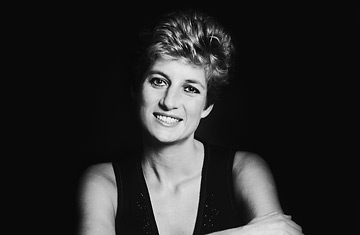
Princess Diana, Princess of Wales (1961 - 1997) posing against a dark background, circa 1995.
(5 of 5)
The sisters are like-minded on one subject: making time for Di's boys. They've attended Harry's Ludgrove soccer games and visited William at Eton. And though the boys' summer schedule has left little time for their aunts (they turned down an invitation to vacation with them and their cousins in Cornwall in August), the sisters are there for their nephews, says the British Press Association's Archer, "at a time when they need friendship and support."
As glamor goes, it's a world away from the Paris Ritz. That's just what Trevor Rees-Jones, 30, had in mind when he quit his desk job at Harrods in April to return to his hometown of Oswestry (pop. 15,000), 200 miles northwest of London. The former paratrooper, who spent last summer watching over his boss's playboy son Dodi Fayed on his travels with Princess Diana, now sells sneakers part-time at a sports store within walking distance of the two-bedroom cottage where he lives alone. (Estranged wife Susan, reported The Sunday Mirror, now lives with another man in the home she once shared with Rees-Jones.)
Meanwhile, twice-weekly physiotherapy sessions, to repair an injury to his left arm that he suffered in the crash, have paid off. Healthwise, "he is coming along well," says a pal. He has also developed a friendship with his physiotherapist Helen Calaghan, 27. But Rees-Jones won't know if — and whom — he can sue for damages until fall, when the Paris judge investigating the crash issues his findings. Until then, says Rees-Jones's lawyer Ian Lucas, "it is difficult for him to move forward with his life."
Diana called him "my rock," and onetime butler and confidant Paul Burrell, 40, continues to have to live up to the title. "Criticism makes him more resilient," says a friend of the man who was the only nonfamily member graveside at Diana's burial. Since then he has been appointed events and fund-raising manager for the Diana, Princess of Wales Memorial Fund (salary: $45,000) and also serves on the government's Memorial Committee, charged with creating a series of Diana commemoratives, including a [sterling] 5 coin. Both jobs have brought controversy. In July newspaper columnists and locals took Burrell to task for his support of a scheme to build a $16 million memorial garden at Kensington Palace, which the art critic Brian Sewell publicly decried as nothing but "a focus for idiot tourists."
More difficult for Burrell, though, was overseeing the dismantling of Diana's 10-room Kensington Palace apartment in the months after her death and the dispersal of her possessions (furnishings and clothes went to Althorp, while her sons had their pick of her photos and beloved stuffed animals). According to an insider the space will remain empty "until the foreseeable future."
Burrell too has been uprooted. Last month he moved out of the three-bedroom apartment he and his wife, Maria, 42, and sons Alexander, 13, and Nicky, 10, occupied at the palace and into a converted barn in Farndon, Cheshire. "Paul is the last thread of the princess at Kensington," says an intimate of the still fiercely loyal Burrell. "The memories he has he will carry until he dies."
Frederic Mailliez crosses Paris's Alma Bridge nearly every day on his way to work and marvels at the crowds gathered at the site, now an unofficial memorial to Princess Diana, who was fatally injured in the tunnel below. "I'm amazed people were so affected by her death that they still come to that spot," he says.
Mailliez, 37, has reason to be more affected than most. A physician specializing in emergency care who works for SOS Mdecins, a private 24-hour house-call service, he was off-duty, driving home, when he came upon the crash moments after it happened. Sizing up the situation — two dead, two seriously injured — he rushed to his car to phone for assistance, grabbed a handheld respirator and ran back to help the princess, while a volunteer fireman who happened by tended to bodyguard Rees-Jones until ambulances arrived minutes later. It wasn't until the next morning that Mailliez learned his patient's identity. "I was surprised," he says. "People surrounded the car; some had cameras, but they never got in my way." In fact, the only obstacle was his lack of equipment. "It was frustrating to be there with almost nothing but my bare hands," he says. "I couldn't even take her blood pressure."
Yet he has the comfort of knowing he did his best — and he believes the others who treated the victims did too. Might Diana have lived if she had reached the hospital sooner? "It's impossible to say," Mailliez says. "I have spoken to emergency and thoracic-surgery experts who don't believe they could have saved her." As for the paparazzi, all nine of whom are still under investigation for manslaughter and non-assistance to accident victims, he says, "I have nothing to reproach them for."
Mailliez, who has testified three times about the crash, will do so again in September. Still, for all the attention, he insists, "this experience has not changed me. The only contribution Ihave to make is to tell the truth. I feel I'm the guardian of a part of Princess Diana's memory."
— With reporting by Simon Perry and Nina Biddle/London; and Cathy Nolan / Paris